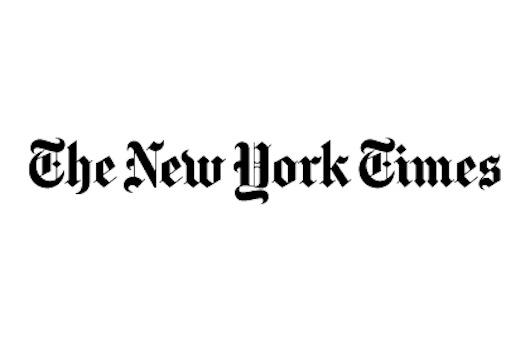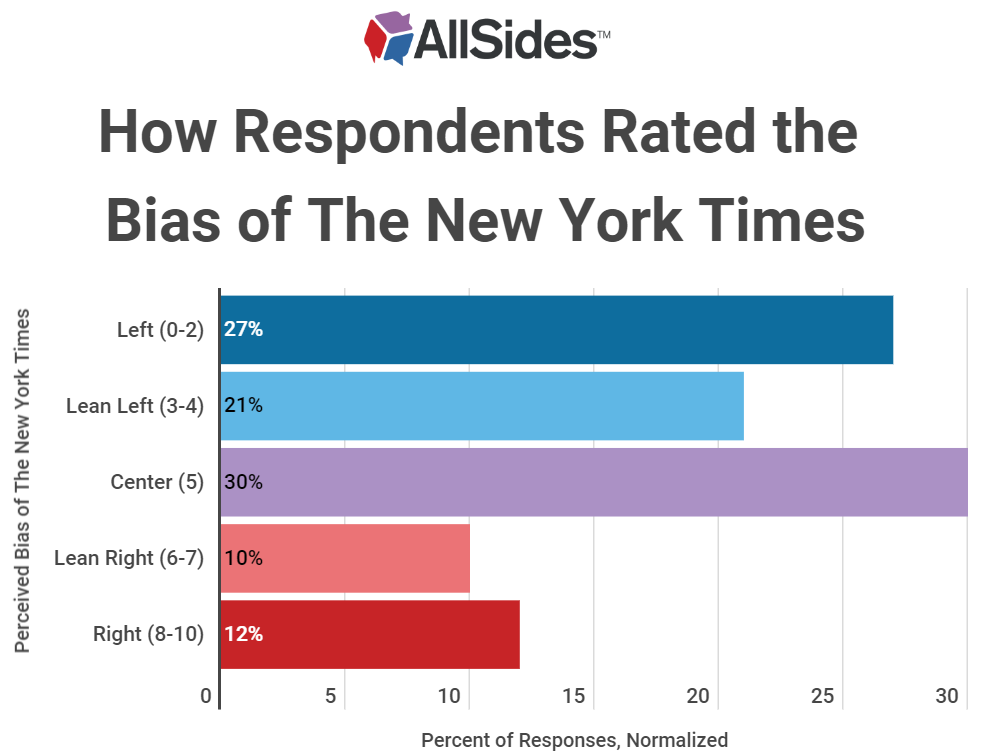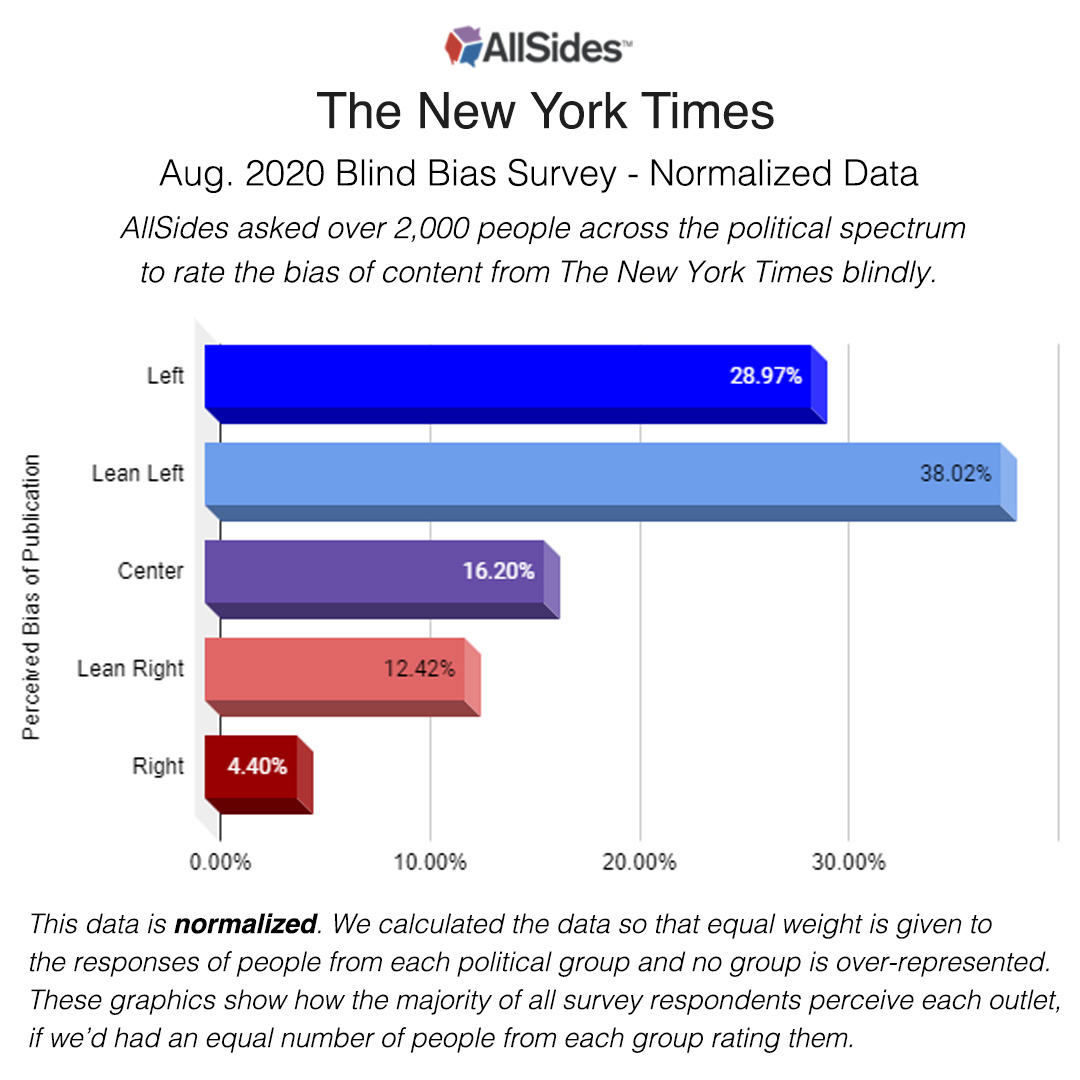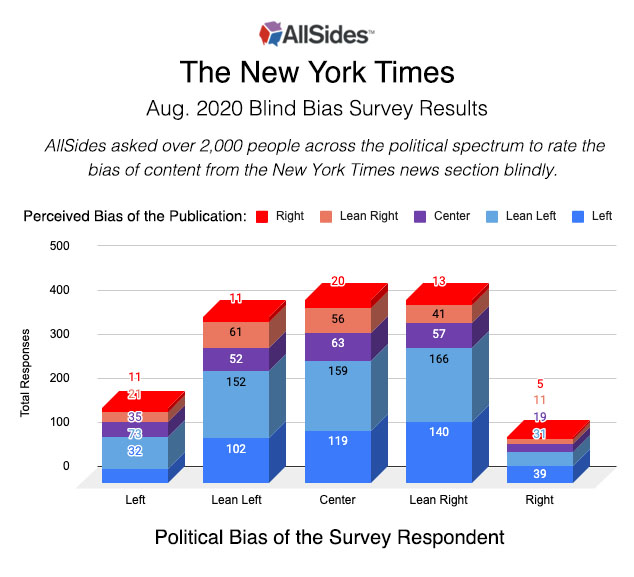New York Times (News)
How we determined this rating:
-
Editorial Review: Jul 2021
- Community Feedback: ratings
- AllSides has high confidence in this bias rating.
Unless otherwise noted, this bias rating refers only to online news coverage, not TV, print, or radio content.
Learn about our bias rating methods
| Bias Rating | Lean Left |
| Type | News Media |
| Region | National |
| Owner | The New York Times Company |
| Established | 1851 |
| Website | nytimes.com |
| @nytimes | |
| nytimes | |
| Wikipedia | New York Times (News) |
About New York Times (News)'s Bias Rating
New York Times (News) is featured on the AllSides Media Bias Chart™.
New York Times (News) is a news media source with an AllSides Media Bias Rating™ of Lean Left.
Important Note: This page refers to the media bias rating for the New York Times' news content only. AllSides provides a separate media bias rating for The New York Times Opinion page.
What a "Lean Left" Rating Means
Sources with an AllSides Media Bias Rating of Lean Left display media bias in ways that moderately align with liberal, progressive, or left-wing thought and/or policy agendas. A Lean Left bias is a moderately liberal rating on the political spectrum.
Learn more about Lean Left ratingsBias Reviews
We use multiple methods to analyze sources. Learn how we rate media bias.- New York Times Rated Lean Left in Oct. 2022 AllSides Blind Bias Survey
- The New York Times Fact Check Section Has Lean Left Bias: July 2021 Editorial Review
- New York Times Accused of Disinformation About a Capitol Officer's Death
- The New York Times Bias Rated Lean Left in August 2020 AllSides Blind Bias Survey
- The New York Times Rated Lean Left in March 2013 AllSides Blind Bias Survey
- Third-Party Studies of New York Times Bias Find Left Bias
New York Times Rated Lean Left in Oct. 2022 AllSides Blind Bias Survey
The New York Times was rated Lean Left in the Oct. 2022 AllSides Blind Bias Survey, confirming AllSides' rating at the time.
A total of 706 people across the political spectrum took the survey. The normalized average for New York Times was -1.32 on a scale from -9 to +9, with 0 representing Center. That average is in the Lean Left category.
Overall, 49% of respondents rated New York Times as left of center, 30% rated it in the exact center, and 22% rated it as right of center.
Notably, the perception of the New York Times' bias differed based on where the respondent lives. New York City metro area residents were more likely to say New York Times is Center.
A national sample of respondents recruited from SurveyMonkey most commonly rated The New York Times as Lean Left, while respondents from AllSides’ national audience of readers rated The New York Times as Left. Meanwhile, respondents in the New York City metro area were most likely to rate The New York Times as Center. (Note this geographic data represents raw responses, not normalized averages).
This underscores that bias is in the eye of the beholder. There are more liberals/Democrats in New York City, and their perception of New York Times’ bias is that it is Center, because its bias more closely matches their own beliefs.
New York Times Fact Check Section Has Lean Left Bias: July 2021 Editorial Review
The New York Times fact check section has a Lean Left bias, according to a July 2021 Small Group Editorial Review by AllSides editors on the left, center, and right.
The New York Times Accused of Disinformation About a Capitol Officer's Death
The New York Times was accused of spreading disinformation in early 2021 after its story about a Capitol police officer being beaten to death with fire extinguisher story turned out to be untrue, after spreading rapidly through the press following the Jan. 6 Capitol breach. The incident has led some to accuse the New York Times of misinformation and fake news.
AllSides details the charges of New York Times disinformation here.
In January 2021, The New York Times reported on the death of officer Brian D. Sicknick, a Capitol police officer who responded to the Jan. 6 Capitol breach. The New York Times initially said that Sicknick was “struck by a fire extinguisher,” citing two unnamed law enforcement officials. But The New York Times updated their initial report a month later, adding a disclaimer: "New information has emerged regarding the death of the Capitol Police officer Brian Sicknick that questions the initial cause of his death provided by officials close to the Capitol Police." The headline has also been changed to “Capitol Police Officer Dies From Injuries in Pro-Trump Rampage.”
The story was finally laid to rest when a medical examiner ruled in April that Sicknick died of natural causes and did not find any evidence of internal or external injuries.
The original Times article was headlined, “He Dreamed of Being a Police Officer, Then Was Killed By a Pro-Trump Mob.”
The Times described the purported event: “Then on Wednesday, pro-Trump rioters attacked that citadel of democracy, overpowered Mr. Sicknick, 42, and struck him in the head with a fire extinguisher, according to two law enforcement officials. With a bloody gash in his head, Mr. Sicknick was rushed to the hospital and placed on life support. He died on Thursday evening.”
Some accused the New York Times of intentional disinformation to make the riots look more deadly than they were. Others see it as an honest mistake made in the midst of a chaotic event (which would make it misinformation, rather than disinformation). Also questioned is whether the Times adequately alerted readers to its correction of the error.
Related: Facts vs Myths: Did a Pro-Trump Mob Beat a Cop to Death?
The New York Times Bias Rated Lean Left in August 2020 AllSides Blind Bias Survey
AllSides' August 2020 Blind Bias Survey, in which over 2,000 people across the political spectrum blindly rated content from numerous media outlets, confirmed our Lean Left bias rating for the New York Times' news section.
The average bias rating for The New York Times across all survey respondents — liberals, centrists, and conservatives — was Lean Left.
A plurality of respondents who self-reported a personal political bias of Left, Lean Left, Center, and Lean Right all rated The New York Times as Lean Left. A plurality of respondents who self-reported a personal bias of Right rated The New York Times as Left.
The New York Times Bias Rated Lean Left in March 2013 AllSides Blind Bias Survey
Results from a March 2013 Blind Survey by AllSides confirmed The New York Times has a Lean Left bias.
Third-Party Studies of New York Times Bias Finds Left Bias
A 2005 study by UCLA found The New York Times news section has a left-wing bias.
A 2007 survey conducted by Rasmussen Reports found that 40% of survey respondents believed the New York Times had liberal bias, 20% thought it had no bias, and 11% believed it to be conservative.
Community Feedback
Feedback does not determine ratings, but may trigger deeper review.As of April 2024, people have voted on the AllSides Media Bias Rating for New York Times (News). On average, those who disagree with our rating think this source has a Lean Left bias.
As of July 2016, the AllSides Media Bias Rating for The New York Times was Lean Left; the majority of the almost 7,000 of the AllSides community disagreed with the Lean Left rating. However, when users were asked what the New York Times news bias rating should be, the average of the votes was actually Lean Left.
Confidence Level
Confidence is determined by how many reviews have been applied and consistency of data.As of April 2024, AllSides has high confidence in our Lean Left rating for New York Times (News). Two or more bias reviews have affirmed this rating or the source is transparent about bias.
Additional Information
The New York Times was founded in 1851 by Henry Jarvis Raymond and George Jones and has been published continuously ever since. The newspaper is ranked 3rd in circulation in the U.S. and 18th in the world. The paper has won 132 Pulitzer Prizes, more than any other news organization. The Times has over 9 million subscribers over 235 countries. The Sunday New York Times has an average print circulation of over 1.1 million papers.
The New York Times Editors' Comments on Bias
In 2004, Daniel Okrent, the then-public editor of The New York Times, wrote an editorial in which he explained that when covering some social issues, such as abortion and same-sex marriage, the paper was in fact a "liberal newspaper."
In 2016, his successor, then-public editor (ombudsman) Elizabeth Spayd wrote that "conservatives and even many moderates, see in The Times a blue-state worldview." Furthermore, she added, "A paper whose journalism appeals to only half the country has a dangerously severed public mission."
However, when she asked Dean Baquet, the then-executive editor, he said he did not "believe that the coverage on most days has a liberal cast." Baquet also said, "We have to be really careful that people feel like they can see themselves in The New York Times. I want us to be perceived as fair and honest to the world, not just a segment of it. It's a really difficult goal. Do we pull it off all the time? No."
Times public editor Arthur Brisbane wrote in 2012, "When The Times covers a national presidential campaign, I have found that the lead editors and reporters are disciplined about enforcing fairness and balance, and usually succeed in doing so. Across the paper's many departments, though, so many share a kind of political and cultural progressivism — for lack of a better term — that this worldview virtually bleeds through the fabric of The Times."
In May 2023, New York Times chairman and publisher A.G. Sulzberger wrote an essay arguing for independent journalism free from "blind spots" and "echo chambers." While "journalists should not be blind to the potential impact their reporting may have," Sulzberger wrote, "journalists should be profoundly skeptical of any argument that favors censoring or skewing what they’ve learned based on a subjective view about whether it may yield a damaging outcome."
Since Eisenhower ran for president in 1956, the New York Times has not endorsed a single Republican nominee for president, but has endorsed every other Democratic candidate.
Third Party Claims of Bias
According to a study by The Economist, which looked at whether news outlets used words more often associated with Democrats and Republicans and assigned those outlets an ideological score, The New York Times' Democratic leaning was around 1.5 Democrat-leaning phrases per 10,000 in 2017. By 2022, its left-of-center slant had grown to 4.
Newsbusters Criticizes New York Times for Coverage of Israel-Gaza Conflict
In April 2024, Newsbusters (view AllSides Media Bias Rating) accused The New York Times of bias and bad reporting for "wantonly taking the word of the Hamas-run Gaza Health Ministry to falsely blame an Israeli airstrike for the infamous al-Ahli hospital bombing, which sparked international furor and mass protests" in October 2023. It also accused NewsGuard, a credibility ratings agency, of ignoring The New York Times' improper reporting.
AEI Report Finds Slant in Coverage of Biden’s Student Loan Forgiveness Plan
The American Enterprise Institute conducted a study of media bias in the coverage of President Biden’s student loan forgiveness plan. The study looked at pieces published in the Los Angeles Times, the New York Times, USA Today, the Wall Street Journal, and the Washington Post. They found that the headlines were usually neutral, but there was considerable bias in who was quoted, with Democratic officials, progressive advocates, and borrowers quoted significantly more than taxpayers or taxpayer advocates. Democratic officials were quoted more than four times as often as Republican ones.
- 49% of quotes were provided by public officials such as members of the Biden Administration, US Department of Education officials, members of Congress, governors, and state attorneys general.
- 81% of quotes were from Biden administration officials and other Democrats, and 19 percent were from Republicans
- 30% of quotes were from borrowers and progressive advocates.
- Policy and legal experts accounted for slightly under 20 percent of the quotes.
- Just over 3% were attributed to individuals identified as taxpayers or taxpayer advocates
- 62% of quotes supported loan forgiveness, 24 percent were critical, and 14 percent were neutral toward loan forgiveness.
The choice of quotes that are primarily from those who support forgiveness shows bias by omission. The quotes also display elitism bias by displaying the perspectives of public officials more prominently than taxpayers.
New York Times (News) Ownership and Funding
Funding and ownership do not influence bias ratings. We rate the bias of content only.Owner: The New York Times Company
The New York Times is owned by the New York Times Company. A. G. Sulzberger Jr. is the chairman of the New York Times company. He is sixth member of the Ochs-Sulzberger family to serve The Times as publisher since 1896. The New York Times company is publicly traded.
Financing and ownership information last updated June 2023. If you think this information is out of date or needs to be updated, please contact us.
Articles from New York Times (News)
This content was curated by AllSides. See our Balanced Newsfeed.











